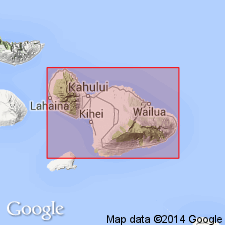
- Usage in publication:
-
- Big Falls picritic basalts*
- Modifications:
-
- Original reference
- Dominant lithology:
-
- Basalt
- AAPG geologic province:
-
- Maui
Summary:
Pgs. 231 (table), 238--241, pl. 1 (geol. map). Big Falls picritic basalts of Hana volcanic series. Called "Turkey Egg lavas" and "Wild Turkey lavas" by local workers. Characterized by prominent phenocrysts of augite and olivine. Commonly very vesicular pahoehoe, locally aa. Typically consists of many thin flow units ranging in thickness from 1 or 2 feet to 20 feet. Maximum thickness about 134 feet. Exhibits moderately developed columnar jointing. Basal unit of series; lies on eroded surface of Kula lavas; in sea cliff east of Hanawi Stream fills gorge cut completely through Kula lavas into Honomanu basalts. Stratigraphically below Makapipi basalts (new) of Hana volcanic series. Age is considered middle(?) and late Pleistocene and Recent (pl. 1).
Named for occurrence at Big Falls on Hanawi Stream, Nahiku area, Haleakala (East Maui) volcano, Island of Maui, HI.
Source: US geologic names lexicon (USGS Bull. 1200, p. 332-333); GNU records (USGS DDS-6; Menlo GNULEX).

- Usage in publication:
-
- Big Falls picritic basalts*
- Modifications:
-
- [Principal reference]
- Age modified
- AAPG geologic province:
-
- Maui
Summary:
Pg. 77-78. Big Falls picritic basalts. Exposed along narrow band with outcrop area of about 0.1 square mile along east side of Hanawi Gulch, in Nahiku area along northeastern side of island. Maximum thickness about 300 feet. Age is considered Pleistocene(?).
[Principal reference]: exposures on face of Big Falls on Hanawi Stream, Haleakala (East Maui) volcano, Nahiku area, [in vicinity of Hanawi Springs, approx. Lat. 20 deg. 48 min. 53 sec. N., Long. 156 deg. 06 min. 15 sec. W., Nahiku 7.5-min quadrangle], eastern part of Island of Maui, Maui Co., HI.
[Additional locality information from USGS GNIS database and USGS historical topographic map collection TopoView, accessed on July 20, 2023.]
Source: US geologic names lexicon (USGS Bull. 1200, p. 332-333); GNU records (USGS DDS-6; Menlo GNULEX).

- Usage in publication:
-
- Big Falls Picritic Basalts†
- Modifications:
-
- Abandoned
- AAPG geologic province:
-
- Maui
Summary:
Big Falls Picritic Basalts (Stearns and Macdonald, 1942) abandoned as formally named unit and called Big Falls flows an informal unit of Hana Volcanics. Hana Volcanics is assigned Pleistocene(?) and Holocene age.
Source: GNU records (USGS DDS-6; Menlo GNULEX).
For more information, please contact Nancy Stamm, Geologic Names Committee Secretary.
Asterisk (*) indicates published by U.S. Geological Survey authors.
"No current usage" (†) implies that a name has been abandoned or has fallen into disuse. Former usage and, if known, replacement name given in parentheses ( ).
Slash (/) indicates name conflicts with nomenclatural guidelines (CSN, 1933; ACSN, 1961, 1970; NACSN, 1983, 2005, 2021). May be explained within brackets ([ ]).

